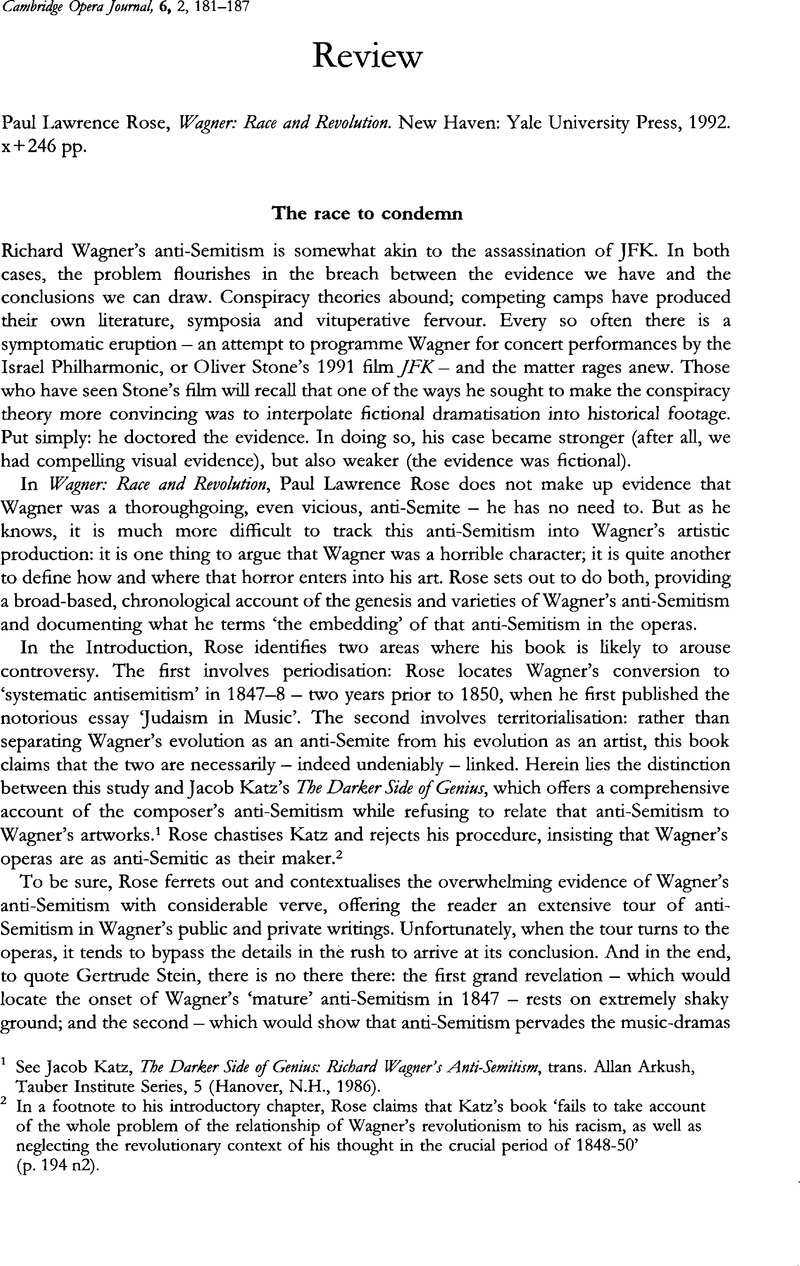No CrossRef data available.
Published online by Cambridge University Press: 27 August 2008

1 See Katz, Jacob, The Darker Side of Genius: Richard Wagner's Anti-Semitism, trans. Arkush, Man, Tauber Institute Series, 5 (Hanover, N.H., 1986).Google Scholar
2 In a footnote to his introductory chapter, Rose claims that Katz's book ‘fails to take account of the whole problem of the relationship of Wagner's revolutionism to his racism, as well as neglecting the revolutionary context of his thought in the crucial period of 1848–50’ (p. 194 n2).
3 Princeton, , 1990.Google Scholar
4 For an account of Wagner's later attempts to repress his relationship with Heine, see Richter, Karl, ‘Absage und Verleugnung: Die Verdrängung Heinrich Heines aus Werk und Bewußtsein Richard Wagners’, in Richard Wagner – Wie antisemitisch darf ein Künstler sein?, ed. Metzger, Heinz-Klaus and Rieten, Rainer, Musik KonZepte, 5 (1978), 5–15.Google Scholar
5 The struggle became all the more urgent in the wake of National Socialism. One of the first critics who attempted – if somewhat gingerly – to reconcile Wagner's odious personal views with his aesthetic production was Thomas Mann, whose famous lecture of February 1933, ‘The Sorrows and Grandeur of Richard Wagner’, created a major scandal in what had just become Hitler's Germany. In a letter to the set designer Emil Preetorius, Mann wrote that ‘there's a good deal of “Hider” in Wagner’. The essay and letter both appear in: Mann, Thomas, Pro and Contra Wagner, trans. Blonden, Allan (Chicago, 1985), 91–148 and 208–11Google Scholar, here 210.
6 However, some aspects of that selection remain rather mysterious. Not only does Rose fail to discuss Wagner's most famous (and arguably his most important) prose work, Opera and Drama, he also fails to discuss why he fails to discuss it.
7 See Adorno, Theodor, In Search of Wagner, trans. Livingstone, Rodney (London, 1981).Google Scholar
8 Barry Milhington explicitly sets out to examine Adorno's point ‘in the depth it deserves’. See his ‘Nuremberg Trial: Is there Anti-Semitism in Die Meistersinger?’, this journal, 3 (1991), 247–60Google Scholar, here 247. Jean-Jacques Nattiez cites Adorno‘s observation as a springboard for a closer examination of whether Wagner inflects the character of Alberich (from The Ring) as Jewish. See Nattiez, Jean-Jacques, Wagner AndroDne: A Studji in Intepretation, trans. Spencer, Stewart (Princeton, 1993), 60.Google Scholar
9 Adorno, , 23Google Scholar; translation modified.
10 Adorno, , 24Google Scholar; translation modified.
11 See Borchmeyer, , ‘The Question of Anti-Semitism’, in The Wagner Handbook, ed. Müller, Ulrich and Wapnewski, Peter; English trans. ed. John Deathridge (Cambridge, Mass., 1992), 166–85Google Scholar, here 184. Borchmeyer makes many of the same points in an Afterword entitled ‘A Note on Wagner's Anti-Semitism’, in Richard Wagner.: Theory and Theatre, trans. Spencer, Stewart (Oxford, 1991), 404–10.Google Scholar Here he claims that ‘there are no Jewish characters in [Wagner's] music dramas, still less any anti-Semitic tendencies. His hatred of the Jews was excluded from the inner sanctum of his artistic personality’ (p. 408). As the editor of a recent ten-volume German language edition of Wagner's writings, Borchmeyer bears responsibility for the astonishing decision to exclude Judaism in Music’. See Wagner, Richard, Dichtungen und Schrii ten, 10 vols, ed. Borchmeyer, Dieter (Frankfurt am Main, 1983).Google Scholar Zelinsky's position is presented in a variety of essays, the most famous of which is ‘Die “Feuerkur” des Richard Wagner oder die “neue Religion” der “Erlösung” durch “Vernichtung”’, in Richard Wagner – Wie antisemitisch dart ein Künstler sein?, 79–112.Google Scholar
12 While Millington's essay focuses entirely on the question of anti-Semitism in Die Meistersinger, Nattiez's various discussions of anti-Semitism are not central to the argument of his book.
13 Millington, , 247.Google Scholar